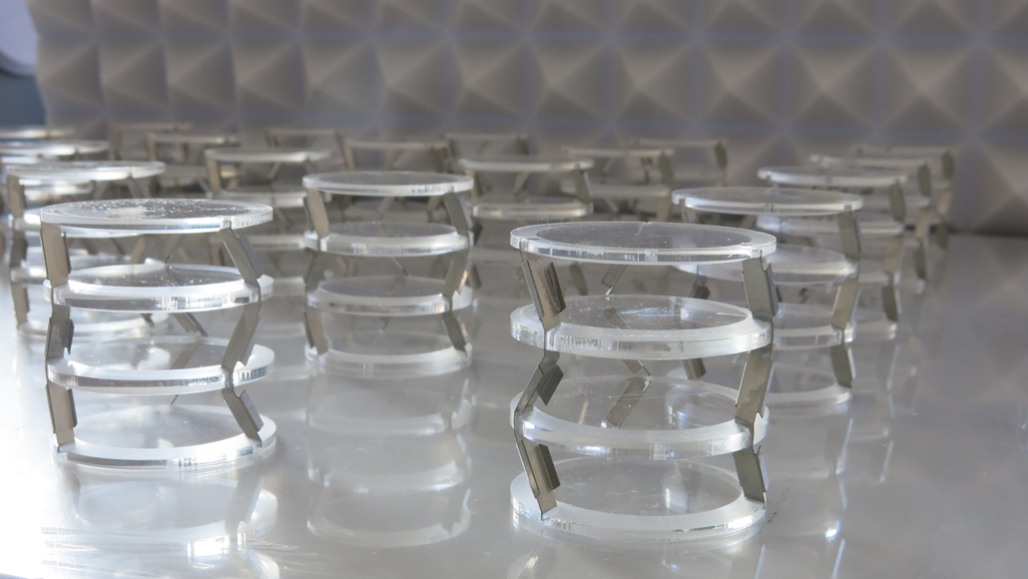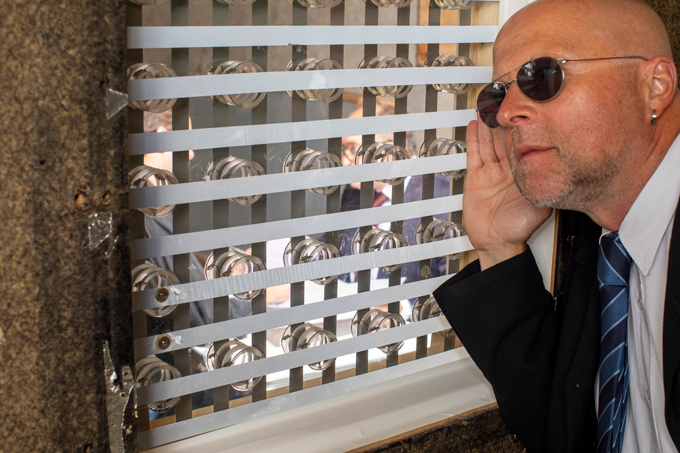New twist can hush — even cloak — some sounds
These materials can be 'tuned' to block some sounds while letting others pass through

These new anti-noise materials, which have a crystal-like appearance, can twist certain vibrations to block some unwanted sounds.
Empa
A twist can make a good thing better, as in the case of ice cream cones, braided hair and the end of a good story. In October, Swiss engineers described how a twist built into building materials can help dampen vibrations. Their innovation stops sound or other forms of vibrations from passing through.
To get some idea of what the new material looks like, imagine connecting the flat sides of two marshmallows — one on top, one on bottom — with three toothpicks. Now twist the top marshmallow. The toothpicks stay connected, but they lean to one side so they’re now diagonal instead of vertical. With more toothpicks and marshmallows, you can make the twisting tower as tall as you’d like.
But not just any twist will do.
Some molecules come in right- and left-handed forms. That handedness is known as chirality (Ky-RAAL-ih-tee). The two forms are mirror images of each other, like a right and left shoe. That chirality describes how the molecule twists along its length. The new materials employ a different type of chirality. The idea is similar, but engineers have used it on a much larger scale. Their material is made of a tower of flat round disks (think of those marshmallows), each connected by three long and narrow links (like the toothpicks). But instead of twisting a molecule, the researchers have twisted the connecting links.
“Chirality is a new twist” to dampen sound, says José Sánchez-Dehesa, who did not work on the new study. He’s an engineer at Polytechnic University of Valencia, in Spain. And he, too, designs sound-insulating materials.
Plenty of materials exist to dampen or block sound. But the new design is up to 100 times lighter-weight than previous materials, say its inventors. And it’s tunable. That means it can be made to block only specific frequencies of noise or vibrations.
Dampening — or quieting — unwelcome vibrations is important to many designs. Airplane makers want to reduce shaking and noise so passengers stay comfortable and the structure’s materials don’t come apart. So do carmakers. Concert halls and recording studios require quiet spaces. That means they need to block the entry of loud sounds from outside.

Because the new material can block certain ranges of vibrations, the researchers say it could fit all of these uses. “If you design a material, ideally you would like to know what knobs you can turn to obtain a certain effect,” says Andrea Bergamini. “You want to be able to control your material.” He is a mechanical engineer who worked on the new project at EMPA. That Swiss research institute, based in Dübendorf, specializes in designing new materials.
His team described its new chiral sound dampening materials October 4 in Nature Communications.
How it works
Snap your fingers. The sound it makes creates a disturbance in the air as some particles push against others. Those particles push against still more particles, and so on. Sound moves from one place to another — such as from your fingers to your ears — through this type of particle-shoving.
Vibrations can move through solids, too. That’s why your pencil quivers if you hit a desk hard with your hand. It’s also why you can hear people talking on the other side of a thin wall. The new invention controls at least some of those sound waves as they attempt to pass through.
Their secret is that twist. The building blocks used in the new material look like small cylinders of stacked round plates (clear marshmallows). Narrow diagonal beams (like those toothpicks) separate each disk. Both the plates and beams are made of a hard plastic. When assembled, these structures resemble a type of large crystal. (A crystal is a material with an internal structure made of repeating geometric patterns.)
Entering sound waves pass through one plastic plate, then past the small plastic beams, and on through the next stacked plate. The crystal’s shape twists the waves of some sound frequencies. (Frequency describes how closely together waves travel.) Those twists serve to bump the waves off course. The material refracts — changes the direction of — some or all of the waves passing through.
The researchers unveiled two designs for their crystal-like structure. One twists the waves, but rotates them in only one direction. That means sounds pass through. By the time the waves reach the end, however, they’ll be distorted. If someone at one end had been speaking, their words could be unintelligible at the other end. Such a design might be useful for creating private rooms. Outsiders would not be able to eavesdrop on what was said inside.
The other design twists first one way, then the opposite. (Imagine you build a tower of many stories of marshmallows, each story separated by and supported by toothpicks. However, the direction of the marshmallow’s rotation reverses with each new floor.)
The researchers demonstrated this design by sandwiching the twisting structures between two plastic windows. Their twisty material completely blocked — or cloaked — some ranges of vibrations. This shows that structures can be designed to have a bandgap, meaning a selected range of blocked frequencies, the researchers say.
The design was challenging
Finalizing this design took about five years of trial and error, says Bergamini. His team began by studying crystals. They have an internal structure made of repeating patterns. People often use crystals to redirect light and other types of electromagnetic radiation.
Recently, scientists realized that if they made larger structures out of repeating patterns, they could redirect larger waves. Such projects allowed them to cloak sounds and seismic waves. Bergamini’s group wanted to find a new way to use a crystal-like design to dampen or mute sound waves. The breakthrough, says Bergamini, came one day at a Swiss cafe. They saw a tile pattern on the floor. For some reason, that design made them think of rotation.
“After a number of mistakes, we got to the idea of introducing chirality — this twist idea,” he says. That was the real innovation.
Researchers used to have only two main ways to create the types of sound-dampening bandgaps that this new material demonstrates, says Marco Miniaci. “You can make the material very dense, or very soft.” Miniaci is an engineer. He works at Empa, too, where he led the project with Bergamini. Those past approaches to sound dampening had their limitations, he notes. A dense material will be heavy. It also can be potentially costly to make, use or maintain. If it’s soft, however, the material may not be rugged enough to stand up in construction designs. The new material is the best of both alternatives, Miniaci says — lightweight and durable.
The Empa team is now working with manufacturers to find ways to put their structural spin — or twist — on the materials that will be used to build cars, planes and other products of the future.
That should be possible, says Sánchez-Dehesa. Moreover, the new material can block a wider range of wavelengths and, potentially, lower pitches. He says that “the design is feasible.” And, he adds, “thanks to advances in 3-D-manufacturing, I see no potential troubles” in building new sound-blocking windows. Their see-through glass would have an invisible, built-in twist.
This is one in a series presenting news on technology and innovation, made possible with generous support from the Lemelson Foundation.







